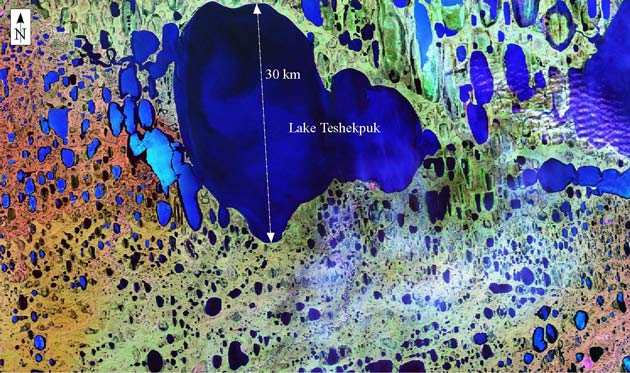Mystery of World's Fastest-growing Lakes Solved

In Alaska, thousands of mysterious lakes are all the same shape and have grown steadily for thousands of years, the geological record shows. They are the fastest growing lakes known in the world.
Scientists have tried various ideas to explain the steady growth -- the lakes expand up to 15 feet every year -- and the lakes' consistent shape and orientation, but no theory has held up.
Now a scientist who has worked previously on puzzles as wide-ranging as the spiral shape of Mars ice caps says he's solved the terrestrial mystery.
The solution might also help explain a series of oddly similar lakes near the U.S. East Coast.
Heat waves
The lakes range from puddle-sized to more than 15 miles long. They are shaped like stretched-out eggs, with their skinny ends always pointing northwest. They're grouped in a vast field twice the size of Massachusetts.
"Lakes come in all sizes and shapes, but they're rarely oriented in the same direction," said Jon Pelletier, an assistant professor of geosciences at the University of Arizona in Tucson.
Get the world’s most fascinating discoveries delivered straight to your inbox.
The odd characteristics result from seasonal slumping of the banks when the permafrost thaws abruptly, Pelletier said today. Permafrost typically includes a top layer, called the active layer, that melts each summer and refreezes in winter.
A lake grows when rapid warming from a sudden heat wave melts its frozen banks and the soggy soil loses strength and slides into the water.
How it works
Previous theories had suggested, among other things, that prevailing winds were behind the shapes.
Pelletier's computer model shows, instead, that heat waves get the credit.
If the temperature warms gradually, the ice portion of the permafrost melts slowly, allowing the water to drain out of the soil and leave relatively firm sand or sediment behind. However, if an early heat wave melts the permafrost's ice rapidly, the result is a soggy, unstable soil.
But why the uniform orientation and shape?
All downhill
The lakes are all on a gently sloping landscape, and the downhill end of a lake always has a shorter bank.
The computer model revealed that shorter banks melt more and have bigger slumps. So when a lake experiences thaw slumping, the lake grows more in the downhill direction than it does uphill, generating the lakes' characteristic elongated-egg shape.
"We knew about the thaw slumping, but we didn't know it had to do with the shape of the lakes," Pelletier said.
To confirm the model reflects reality, Pelletier plans to check whether the lakes have indeed grown more in the downhill direction, as the computer predicts.
"It can be done by comparing aerial photos over time but no one's done it," he said. "There are a lot of photos from past decades."
A computer model describing the process will be published June 30 in the Journal of Geophysical Research.
The Carolina Bays
A variation of the computer model might eventually explain a series of lakes from Maryland to Georgia that also share a similar orientation.
The Carolina Bays, as they are known, all point back at a single faraway spot, and they're all oriented toward the coast. Scientists have suggested they might have been created all at once when an ancient meteor hit Earth at an oblique angle. Large fragments sprayed out and dug the lakes into existence, the thinking goes.
Pelletier suspects there might be a better explanation.
"These Carolina Bays look awfully similar" to the Alaskan lakes, he told LiveScience in a telephone interview.
So he tweaked his model to account for the differing conditions. Instead of permafrost, the Carolina Bays sit atop limestone. The lake water was made to virtually dissolve the limestone in a manner that generated lakes with uniform orientations that match the real versions.
Pelletier cautioned that this possible explanation for the Carolina Bays is for now "very speculative."
Image Gallery
Earth from Above
Robert is an independent health and science journalist and writer based in Phoenix, Arizona. He is a former editor-in-chief of Live Science with over 20 years of experience as a reporter and editor. He has worked on websites such as Space.com and Tom's Guide, and is a contributor on Medium, covering how we age and how to optimize the mind and body through time. He has a journalism degree from Humboldt State University in California.



